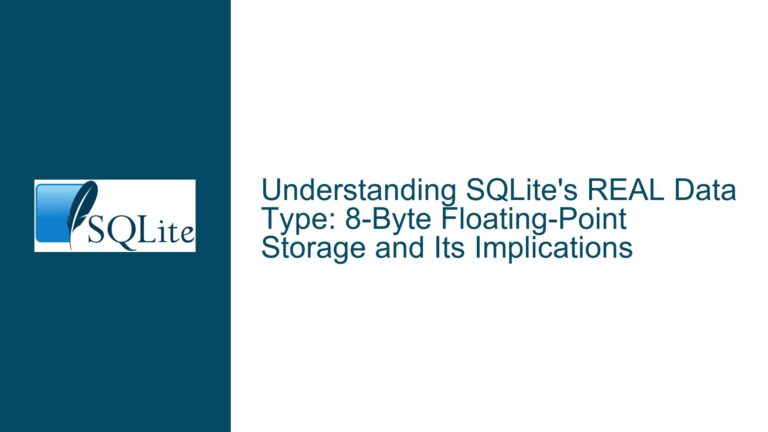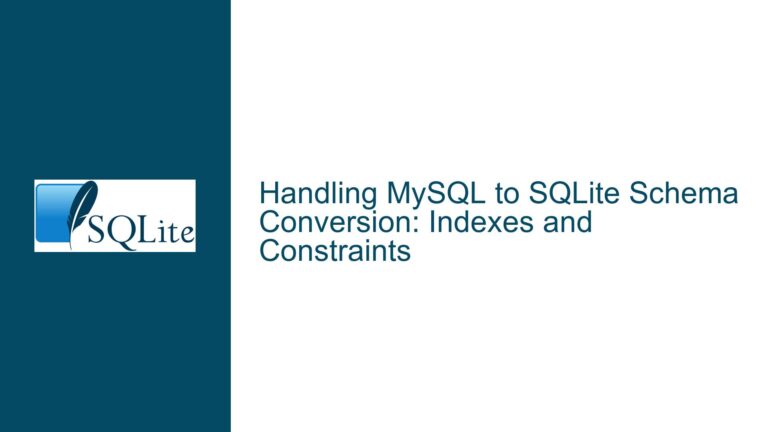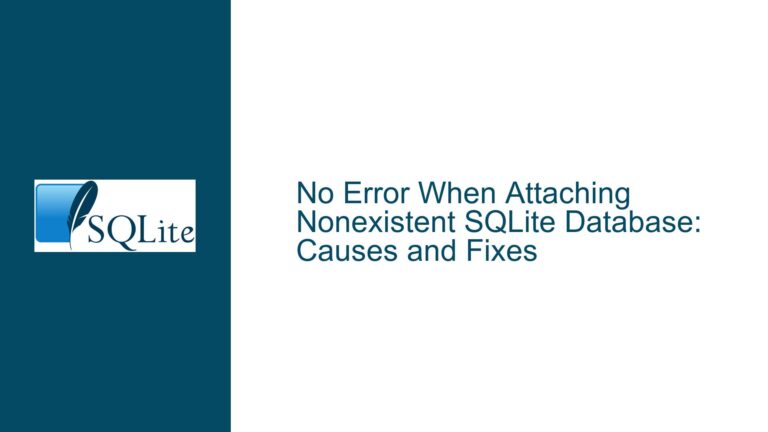Using FTS5 as a GIN-like Index for JSONB-like Queries in SQLite
JSONB-like Indexing with FTS5: A Conceptual Overview
The core issue revolves around implementing JSONB-like indexing in SQLite, a feature that is natively supported in PostgreSQL but absent in SQLite. The goal is to enable efficient querying of multiple JSON values without creating a unique index for every possible combination of fields. The proposed solution involves leveraging SQLite’s Full-Text Search (FTS5) module in ASCII mode to simulate a GIN (Generalized Inverted Index) index. This approach involves encoding JSON paths and their corresponding values as hex strings, which are then indexed by FTS5. The idea is to use FTS5’s ability to handle space-separated tokens to facilitate multi-value queries.
The JSON object provided in the discussion serves as an example:
{
"abc": "def",
"def": [1, 2, 3]
}
The proposed encoding scheme would convert each JSON path and value into a hex-encoded string, separated by spaces. For instance, the key-value pair "abc": "def" would be encoded as hex("abc:'def'"), and the array "def": [1, 2, 3] would be encoded as hex('def:1'), hex('def:2'), and hex('def:3'), all concatenated with spaces in between. This encoding allows FTS5 to index each JSON path and value as a separate token, enabling queries that target multiple JSON values simultaneously.
However, this approach raises several questions and potential issues. First, the encoding scheme must be consistent and reversible to ensure that queries can accurately retrieve the original JSON data. Second, the performance implications of using FTS5 in this manner need to be carefully considered, as FTS5 is optimized for full-text search rather than structured data indexing. Finally, the limitations of FTS5, such as its handling of tokenization and its lack of support for certain types of queries, must be addressed to ensure that the solution is robust and scalable.
Potential Flaws and Limitations of Using FTS5 for JSONB-like Indexing
While the proposed solution is innovative, it is not without its potential flaws and limitations. One of the primary concerns is the suitability of FTS5 for this use case. FTS5 is designed for full-text search, which involves indexing and querying large volumes of unstructured text data. In contrast, JSONB-like indexing involves structured data, where each JSON path and value pair must be precisely indexed and retrieved. This mismatch in design goals could lead to inefficiencies and unexpected behavior when using FTS5 for JSONB-like indexing.
Another potential issue is the encoding scheme itself. While hex encoding ensures that JSON paths and values can be represented as strings, it also introduces additional complexity. For example, the encoding process must handle special characters, nested JSON structures, and arrays consistently. Any inconsistency in the encoding scheme could result in incorrect indexing or failed queries. Additionally, the hex-encoded strings may be significantly longer than the original JSON data, which could impact storage requirements and query performance.
The tokenization process used by FTS5 is another area of concern. FTS5 tokenizes text data into individual tokens based on predefined rules, which may not align with the requirements of JSONB-like indexing. For example, FTS5 may treat certain characters (e.g., colons, commas, and brackets) as token separators, which could interfere with the accurate indexing of JSON paths and values. This misalignment could lead to incomplete or incorrect query results, particularly for complex JSON structures.
Finally, the proposed solution does not address the issue of query flexibility. In PostgreSQL, GIN indexes support a wide range of query operators, including containment, existence, and path-based queries. FTS5, on the other hand, is primarily designed for keyword-based searches and may not support the same level of query flexibility. This limitation could restrict the types of queries that can be performed on the indexed JSON data, reducing the overall utility of the solution.
Step-by-Step Troubleshooting and Alternative Solutions
To address the issues and limitations identified above, a step-by-step approach is necessary to ensure that the proposed solution is both effective and efficient. The first step is to carefully evaluate the encoding scheme to ensure that it is consistent and reversible. This involves testing the encoding process with a variety of JSON structures, including nested objects, arrays, and special characters. Any inconsistencies or edge cases should be identified and addressed to ensure that the encoded data can be accurately indexed and queried.
Next, the performance implications of using FTS5 for JSONB-like indexing should be thoroughly evaluated. This involves benchmarking the indexing and querying processes with a representative dataset to identify any potential bottlenecks or inefficiencies. If performance issues are identified, alternative approaches may need to be considered, such as using a custom tokenizer or pre-processing the JSON data to optimize it for FTS5 indexing.
The tokenization process used by FTS5 should also be carefully examined to ensure that it aligns with the requirements of JSONB-like indexing. If necessary, a custom tokenizer can be implemented to handle JSON paths and values more accurately. This may involve modifying the tokenization rules to treat certain characters (e.g., colons and brackets) as part of the token rather than as separators. Additionally, the tokenizer should be designed to handle nested JSON structures and arrays consistently to ensure that all relevant data is indexed.
Finally, the query flexibility of the proposed solution should be evaluated to ensure that it meets the requirements of the application. If FTS5’s query capabilities are insufficient, alternative approaches may need to be considered. One possible alternative is to use a combination of FTS5 and traditional SQLite indexes to achieve the desired level of query flexibility. For example, FTS5 could be used to index the JSON data, while traditional indexes could be used to support specific query operators or path-based queries.
In conclusion, while the proposed solution of using FTS5 as a GIN-like index for JSONB-like queries in SQLite is innovative, it is not without its challenges. By carefully evaluating the encoding scheme, performance implications, tokenization process, and query flexibility, it is possible to develop a robust and efficient solution that meets the requirements of the application. However, it is important to recognize that this approach is a workaround and may not provide the same level of functionality and performance as native JSONB indexing in other databases. As such, it is essential to weigh the benefits and limitations of this approach before implementing it in a production environment.






